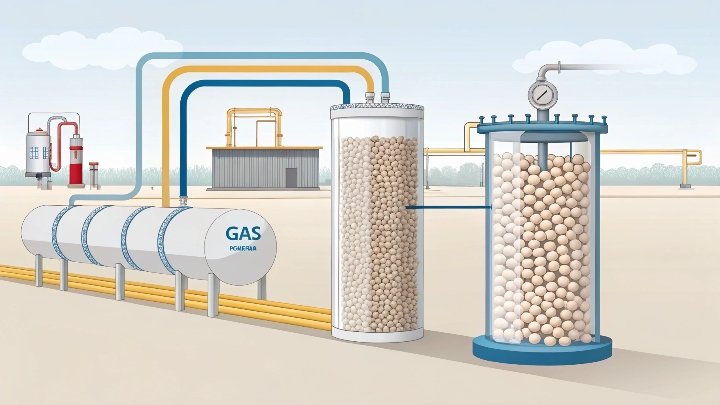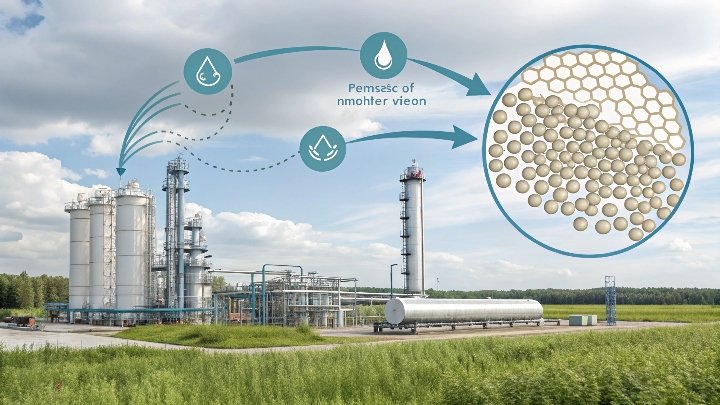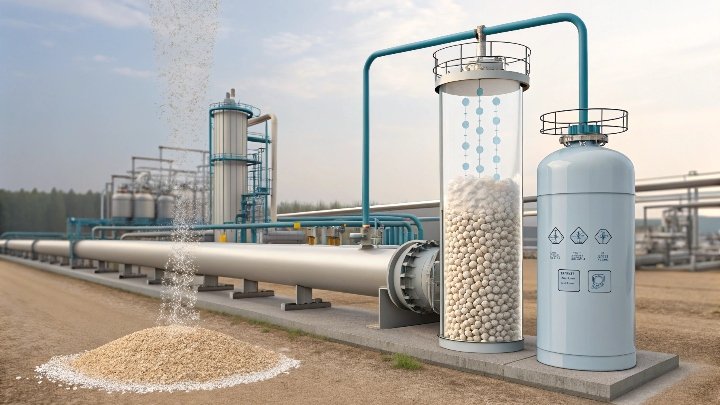I have seen pipelines face crippling corrosion. That stress gets worse when moisture sneaks in. I want to reveal a tested approach that cuts this risk.
Yes, the CNM 4A molecular sieve is my top pick for gas dehydration. It stands up to extreme moisture. Its precise structure grabs water molecules and stops pipeline damage before it starts.
I used to believe any ordinary dehydration method would protect my production line. Then I discovered the true champion that outshines the rest.
Meet the 3A and 4A Molecular Sieves: The Dynamic Duo of Drying?
Moisture can slow my gas production targets. That hidden water can sabotage quality. The 3A and 4A sieves step up to rescue pipelines from leaks and corrosion.
3A and 4A molecular sieves excel at taking moisture away from natural gas. They prevent hydrate formation. Both are known for stable performance and simple regeneration.
Beneath the surface, 3A and 4A molecular sieves show a keen ability to trap water. Their pore sizes target water molecules so they cannot roam in the system. I like how 3A sieves handle molecules with a smaller radius, which is good for many gas streams that require precise drying. 4A sieves can handle a wider range of molecules, which gives more flexibility in natural gas applications. I also see that each one has its own strengths. The 3A type often finds use in processes that must avoid co-adsorbing other molecules. The 4A type often appears in heavy-duty dehydration setups. Its broad pore size helps it remove water quickly.
I have watched how pipeline blockages can form when free water meets other compounds. That water leads to hydrates that choke lines and damage production. So I need a strategy that removes moisture right at the feed gas stage. The 3A or 4A sieve does this job in a reliable way. On top of that, each type is easy to regenerate. The spent sieve can be heated or purged with dry gas, which helps it release trapped moisture and stand ready for more work.
I often get asked which one to pick. In many cases, 4A shines for natural gas dehydration. Its wider pore size suits multiple feed conditions and can grab more water per cycle. My colleagues prefer 3A for certain feed gases that demand higher selectivity. I also keep in mind that 3A might cost more, but the cost can pay off if I need to reduce co-adsorption of other molecules. The best choice comes down to feed composition and system design needs. Here is a quick snapshot of how I compare them:
| Sieve Type | Pore Size | Typical Use Case |
|---|---|---|
| 3A | ~3 Å | Moisture removal, minimal co-adsorption |
| 4A | ~4 Å | Broad moisture removal, larger capacity |
These two sieves stand together like a dynamic duo. They share many traits, but each one also offers unique benefits. I like to say they are both heroes in natural gas dehydration. I have relied on them many times, and they rarely let me down. When I want to keep pipelines free of clogs and corrosion, I look to these reliable solutions. With the right choice and good design, these sieves protect equipment, save money, and prevent production delays. That is why I always recommend them to anyone dealing with moisture in natural gas.
How Molecular Sieves Work Their Magic: Trapping Moisture Like a Pro?
Pipelines can fail if water is not locked down. I had a close call years ago. The fix was simpler than I thought: choose the correct molecular sieve.
These sieves use selective pore structures to trap water. They capture moisture deep inside, then let you remove it. That process keeps corrosion and clogs away.
I marvel at how molecular sieves use physical adsorption. The principle is straightforward. Water molecules are drawn into the tiny pores by weak forces. Those forces are enough to hold them, but not so strong that the water stays forever. This means I can regenerate the sieve later. That is a big advantage over other methods that might rely on chemical reactions or single-use materials. I first saw this in action when I checked a dehydration unit. The feed gas was high in moisture, plus it had carbon dioxide and hydrogen sulfide. Those acid gases, combined with water, could create dangerous liquids that corrode steel. That leads to serious upkeep costs and safety concerns.
When I watch the dehydration tower in action, I see how the feed gas enters the bed. Moisture molecules slip into the pores of the sieve. Then, the purified gas leaves through the outlet. The end product has very low water content. This protects downstream processes like liquefaction or further separation steps. I also see how the bed eventually reaches saturation. At that point, I switch to a standby tower while regenerating the saturated bed. The regeneration is done by raising temperature or sweeping with dry gas. That drives out the trapped water, so the sieve is ready for more.
It is a cyclical process. But the beauty is that it keeps running if I follow the correct steps. The molecular sieve does not create pollutants. The water is simply released in regeneration. I have found CNM 4A to be especially good at this deep drying approach. It targets moisture while still letting other hydrocarbons pass. That is vital, because I do not want to lose key components in my product stream. CNM 4A also resists damage from feed contaminants. Its high compressive strength stands up to rigorous cycles. In my experience, this helps reduce downtime and lowers the risk of bed collapse.
Another point I look at is carbon dioxide and hydrogen sulfide removal. CNM 4A can adsorb these acidic gases. That means less risk of forming corrosive liquids. I remember a project where we faced severe corrosion in the pipeline. We switched to a CNM 4A bed, and the results were immediate. We saw fewer pipeline issues and better system integrity. This is all due to the clever pore design that prioritizes water but can also capture other troublesome components.
Below is a short table to highlight how molecular sieves do their magic:
| Key Feature | Result | Benefit |
|---|---|---|
| Selective pore size | Only admits water molecules | Prevents unwanted adsorbent saturation |
| Physical adsorption | No chemical byproducts | Easy to regenerate |
| Robust structure | Resists crushing and poisoning | Long lifespan, minimal downtime |
| Wide capacity range | Handles varied gas streams | Flexible for different operations |
I like the simplicity of this process. Natural gas producers do not need complicated reagents. They only need to set up the right bed design. I also enjoy how this technology helps the environment. It does not generate harmful wastes. Water is the main substance removed, and that is usually safe to dispose of. This approach protects my bottom line. It also protects the planet. That balance is why I fully endorse the molecular sieve approach to moisture control in natural gas.
Why Natural Gas Needs a Superhero: The Importance of Deep Drying?
Moisture can cause chaos in natural gas pipelines. I saw entire systems go offline because hydrates formed thick plugs. A preventive measure is vital.
Deep drying fights corrosion, plugging, and downtime. CNM 4A molecular sieves target water so thoroughly that costly pipeline blockages never happen.
I recall the day I realized how crucial deep drying is. A friend of mine in the industry shared horror stories of entire plants shutting down when hydrates formed. They had to dismantle pipes to clear the blockages. That was expensive and time-consuming. I asked him about the root cause. He told me water had combined with light hydrocarbons at low temperatures. This formed ice-like solids. They jammed the lines until the plant lost production. That story pushed me to adopt deeper dehydration strategies. I wanted to avoid that nightmare scenario in my own operations.
Deep drying stops these problems by ensuring that feed gas has almost no water left. Without water, hydrates cannot form. The risk of acid formation with carbon dioxide or hydrogen sulfide also shrinks. This means no sudden acid attacks on metal surfaces. I value that, because I have seen how pipeline corrosion leads to leaks and threats to worker safety. The CNM 4A molecular sieve steps up as a superhero because it can handle high moisture loads. It also traps acid gases. So it knocks out two problems at once. That synergy reduces the chance of pipeline clogs and corrosion.
I trust CNM 4A because it is cost-effective. It runs on physical adsorption, which does not create pollutants. In my early days, I tried other adsorbents that left behind spent chemicals or complicated waste streams. That was frustrating. With CNM 4A, I can reuse the same bed for a long time. High compressive strength helps it avoid fractures. That lowers replacement costs. Also, the adsorbent consistently meets strict dryness specifications. So I do not stress about potential contamination of the next process step. My biggest takeaway is that investing in the right adsorbent pays off quickly. Less downtime. More consistent throughput. Happier clients and safer workers.
Here is a final look at some key reasons why deep drying is essential:
| Reason | What Happens Without Deep Drying | Benefit of Deep Drying |
|---|---|---|
| Hydrate prevention | Pipes can clog with ice-like crystals | Smooth flow, fewer production stops |
| Corrosion control | Acidic liquids eat away at equipment | Longer pipeline life, lower costs |
| Quality assurance | Gas composition can shift | Stable product specs, reliable supply |
| Equipment protection | Valves and compressors get damaged | Reduced repair expenses |
I pay close attention to all these points because my goal is to deliver a pure, stable gas product. Moisture is the enemy of that goal. CNM 4A is the ally that helps me win each time. I no longer worry about unstoppable blockages or out-of-control corrosion. This approach safeguards my system. It also boosts my confidence in hitting production targets without nasty surprises.
Conclusion
I see CNM 4A molecular sieve as a true guardian. It keeps my pipelines dry and my process on track.






